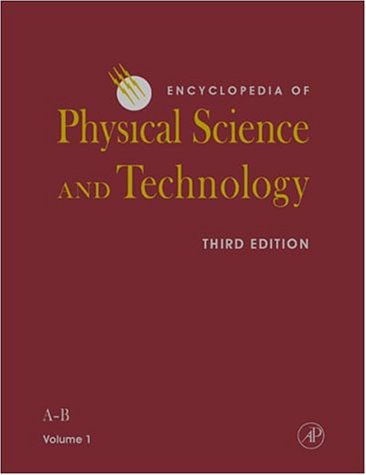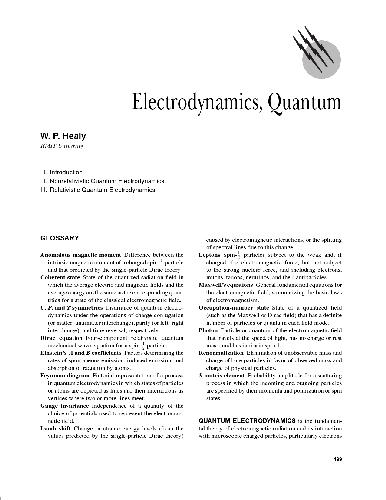Robert Allen Meyers (Editor)9780122274107
The new 18-volume edition of the Encyclopedia of Physical Science and Technology, 3E, will have the added feature of an Index Volume, containing abstracts of all of the articles in the encyclopedia.
The latest edition of the Encyclopedia of Physical Science and Technology:
Has been completely updated with no less than 90% revised material and 50% new content throughout the volumes
Presents eighteen volumes, nearly 800 authoritative articles and 14,500 pages
Is lavishly illustrated with over 7,000 photographs, illustrations and tables
Presents an increased emphasis on the hottest topics such as information processing, environmental science, biotechnology and biomedicine
Includes a final Index Volume containing Thematic, Relational and Subject indexes
Table of contents :
Cover……Page 1
Table of Contents (with page links)……Page 346
Introduction……Page 2
Vibrational Transitions……Page 3
Line Radiative Transfer……Page 4
Masers……Page 5
Dust……Page 6
The Environment of the Interstellar Medium……Page 7
Gas-Phase Chemistry……Page 8
Ionization……Page 9
Shock Chemistry……Page 10
Carbon……Page 11
Water as a special case……Page 12
Isotopic fractionation……Page 13
Cosmological Chemistry……Page 14
References……Page 15
Historical Introduction……Page 16
The Two-Body or Central Field Problem……Page 19
Gravitational Potential Theory……Page 20
Perturbation Theory……Page 21
Lunar Theory……Page 22
The Three-Body Problem……Page 23
N-Body Problems……Page 24
Orbital Resonances……Page 25
Planetary Ring Dynamics……Page 26
Stellar and Galactic Dynamics……Page 27
Chaos Theory and Celestial Mechanics……Page 28
References……Page 29
Glossary……Page 30
Introduction and History……Page 31
Physical Concepts……Page 32
Energies, Spectra, and Composition……Page 35
Origin of Galactic Cosmic Rays……Page 36
The Cosmic Rays Between 3 and 50 EeV, the Expected GZK Cutoff……Page 37
Particles Beyond the GZK Cutoff……Page 39
Outlook……Page 41
References……Page 42
Glossary……Page 43
Value of Some Early Questions……Page 45
Newtonian Dynamics and Gravitation……Page 46
Viewing the Island Universe……Page 47
New Theoretical Models……Page 48
New Observational Evidence……Page 49
Finite or Infinite Space……Page 50
Observations and Significance of Large-Scale Structure……Page 51
Viability of Nonstandard Models……Page 52
Constraints from Cosmology……Page 53
Singularities and Quantum Gravity……Page 54
Emerging Observational Technologies……Page 55
See also the Following Articles……Page 56
References……Page 57
Glossary……Page 58
Fundamental Concepts and Terminology……Page 59
Nuclear Gamma-Ray Lines……Page 61
A Brief History of Gamma-Ray Astronomy……Page 62
The Compton Gamma-Ray Observatory……Page 64
The Sun……Page 66
The Solar System……Page 67
Galactic Sources……Page 68
Accreting Pulsars……Page 69
Black-Hole Binary Systems……Page 70
Nucleosynthesis in Stars and Supernovae……Page 71
Electron–Positron Annihilation Radiation……Page 72
Diffuse Galactic Gamma-Ray Emission……Page 74
Active Galaxies……Page 76
Gamma-Ray Bursts……Page 78
The Extragalactic Diffuse Gamma-Ray Emission……Page 81
Unidentified Gamma-Ray Sources……Page 82
The Photoelectric Effect……Page 84
Attenuation and Absorption of Gamma Radiation……Page 85
Neutron-Induced Background……Page 86
Time-of-Flight (TOF) Discrimination……Page 87
Medium-Energy (MeV)……Page 88
High Energy (MeV to GeV)……Page 89
Very High Energy (GeV to TeV, and above)……Page 90
Future Missions and Prospects……Page 91
References……Page 93
Introduction to Gravitational Radiation……Page 94
Observation Techniques……Page 96
Resonant Mass Detectors……Page 97
Pulsar Timing……Page 98
Data Analysis Methods……Page 99
Bars……Page 100
Detection of a Stochastic Background……Page 101
Nascent Neutron Star Boiling and Neutrino Emission……Page 102
Isolated Pulsars……Page 103
Low-Mass X-Ray Binaries……Page 104
Binary Neutron Stars……Page 105
Binaries with White Dwarfs and Dwarf Stars……Page 106
Limits Based on Nucleosynthesis……Page 107
Outlook……Page 108
References……Page 109
Glossary……Page 110
Indirect Evidence for Gravitational Waves……Page 111
Gravitational Wave Sources……Page 112
Coalescing Binaries……Page 113
Basic Principles……Page 114
Photon Shot Noise and Radiation Pressure Noise……Page 116
Thermal Noise……Page 117
Other Noise Sources……Page 118
Interferometric Detectors in Operation……Page 119
Long Baseline Interferometers under Construction……Page 120
Basic Principles……Page 121
Electronic Noise……Page 122
Gravitational Detectors Network……Page 123
Interferometric Detectors……Page 124
Conclusions……Page 125
References……Page 126
Glossary……Page 127
Introduction to Imaging……Page 128
Image Restoration……Page 129
Bayes Theorem……Page 130
Maximum Entropy Applied to Images……Page 131
Data Constraints……Page 132
Entropy Measures……Page 133
General Properties……Page 134
Hubble Space Telescope……Page 136
Radio Interferometric Image Restoration……Page 137
References……Page 140
Glossary……Page 141
Infrared Bands……Page 142
Objects That Radiate Infrared Light……Page 143
Reradiated Light……Page 144
Cosmic Background Radiation……Page 145
Stellar Radiation in Galaxies……Page 146
Midinfrared (8–30 µm)……Page 148
Bolometers……Page 149
Infrared Astronomical Instruments……Page 150
Spectrometers……Page 151
New Large Telescopes……Page 152
Adaptive Optics……Page 153
Limitations of Space-Based Observations……Page 154
InfraRed Astronomical Satellite……Page 155
Infrared Space Observatory……Page 156
Multiband Imaging Photometer……Page 158
High-Altitude Balloons……Page 159
Large Ground-Based Telescopes and Adaptive Optics……Page 160
References……Page 161
Glossary……Page 162
Atomic Parameters……Page 163
Differential Zeeman Broadening……Page 164
Dust and Interstellar Polarization……Page 165
Stellar Magnetic Fields……Page 166
The Sun and Solar-Type Main Sequence Stars……Page 167
Magnetic Activity in Close Binary Stars……Page 168
White Dwarf Magnetic Fields……Page 169
Interstellar Magnetic Fields……Page 170
Galactic Scale Magnetic Fields……Page 171
Dynamo Generation of Magnetic Fields……Page 172
Flux-Freezing……Page 173
The Dynamo Number and Scaling Relations……Page 174
Planetary Magnetic Fields as Tests for Dynamo Mechanisms……Page 175
Final Words……Page 176
References……Page 177
Millimeter Astronomical Observatories……Page 178
Frequency Switching……Page 179
Interferometric Techniques……Page 180
Molecular Clouds……Page 181
Measurements of Physical Conditions……Page 182
Molecular emission as a tracer of physical conditions……Page 183
Dust Emission as a Tracer of Physical Conditions……Page 186
Isolated and Clustered Star Formation Properties……Page 187
Evolved Stars……Page 188
Grain Surface Chemistry……Page 189
Comets……Page 191
Asteroids……Page 192
Morphological Studies……Page 193
Galactic Evolution……Page 194
References……Page 195
Glossary……Page 197
Classification of Neutrinos as Elementary Particles……Page 198
Interactions with Nuclei……Page 199
Theoretical Solar Models……Page 200
The Chlorine Solar Neutrino Experiment……Page 202
The Kamiokande-II Solar Neutrino Detector……Page 204
The Gallium Experiments……Page 206
Atmospheric (or Cosmic Ray) Neutrinos……Page 207
Interpretation of Data……Page 208
Conclusions……Page 209
References……Page 210
Glossary……Page 211
History……Page 212
Radar Systems……Page 213
Echo Time Delay and Doppler Frequency……Page 218
Radar Waveforms……Page 219
Albedo and Polarization Ratio……Page 220
Dynamical Properties from Delay/Doppler Measurements……Page 221
Dispersion of Echo Power in Delay and Doppler……Page 222
Angular Scattering Law……Page 224
Radar Mapping of Spherical Targets……Page 226
Venus Revealed by Magellan……Page 229
The Radar Heterogeneity of Mars……Page 231
Asteroids……Page 232
Jupiter’s Icy Galilean Satellites……Page 237
Comets……Page 240
Saturn’s Rings and Titan……Page 242
References……Page 243
Glossary……Page 245
Brief History……Page 246
Thermal (Blackbody) Radiation……Page 247
Effective Temperatures of the Planets……Page 250
Radiative Transfer in Planetary Atmospheres……Page 251
Radiative Transfer in Planetary Subsurfaces……Page 253
Nonthermal Radio Emission……Page 254
Instrumentation for Planetary Radio Astronomy……Page 255
Spacecraft……Page 259
Mercury……Page 260
Venus……Page 261
Mars……Page 263
Jupiter……Page 264
Saturn……Page 267
Neptune……Page 268
Comets……Page 269
References……Page 270
Theory of Interferometry……Page 271
Design of a Radio-Interferometric Array……Page 273
Imagine With Radio-Interferometric Arrays……Page 274
Sensitivity, Radio Frequency Interference, and Imaging Algorithms……Page 276
Millimeter Interferometry……Page 278
Space-Based Very-Long-Baseline Interferometry……Page 281
References……Page 282
Glossary……Page 283
Telescope Size Considerations and Light-Gathering Power……Page 284
Telescope Characteristics Related to Size……Page 285
The New Giant Telescopes……Page 287
Combining the Light from an Array of Telescopes……Page 288
Basic Optical Configurations: Single and Multielement……Page 289
Wide Field Considerations……Page 290
Instrumental Considerations: Detector Matching and Baffling……Page 292
Refractors……Page 293
Reflectors……Page 294
Mechanical Configurations……Page 295
Equatorial Mounts……Page 296
Considerations of Usage and Location……Page 297
Remote Observing on the Ground……Page 298
Observing in Space: The Hubble Space Telescope……Page 299
References……Page 301
Glossary……Page 302
Significance of The Research……Page 303
Instrumentation for Ultraviolet Space Astronomy……Page 304
The Sun……Page 308
Planetary Atmospheres……Page 311
Hot Stars……Page 316
Interstellar Gas……Page 319
Interstellar Atomic and Molecular Hydrogen……Page 320
Emission Nebulae……Page 322
Interstellar Dust……Page 324
Extragalactic Objects……Page 325
References……Page 327
Glossary……Page 329
Production and Absorption of X-Rays……Page 330
X-Ray Imaging Systems……Page 331
X-Ray Detectors……Page 332
The Discovery of Cosmic X-Ray Sources……Page 333
The First Surveys……Page 334
Imaging the X-Ray Sky……Page 335
ROSAT: Large-Scale Spectral Imaging……Page 336
Chandra: The Finest X-Ray Camera……Page 337
Normal Stars……Page 338
Compact Objects and Accretion……Page 339
Supernova Remnants……Page 341
Active Galaxies……Page 342
Galaxy Clusters……Page 343
Future Directions……Page 344
Refrences……Page 345







Reviews
There are no reviews yet.